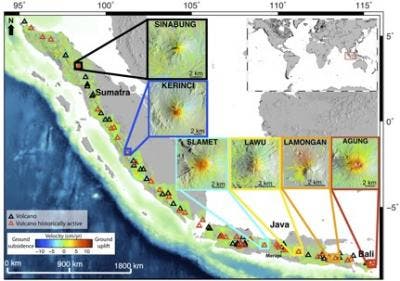In a groundbreaking study, researchers at University of Miami (UM) Rosenstiel School of Marine & Atmospheric Science used satellite imagery to study volcanic eruptions from the past years in Indonesia’s west Sunda arc, a highly active volcanic region. Their findings show that images of inflating magma balloons hint towards impending volcanic eruptions in one in two cases, on average. Considering these deformations can be detected remotely via satellite means that future eruptions can be predicted with much greater accuracy, while also providing an alternative to ground based observations.

The team studied satellite image surveys of dozens of Indonesian volcanoes taken between 2006 and 2009, essentially taking their pulse, and saw ground deformation in six volcanoes, three of which erupted after the observation period, confirming that inflation is a common precursor of volcanic eruptions at west Sunda volcanoes.
“Surveying entire volcanic regions using satellite data is of primary importance to the detection of ground deformation prior to the onset of eruptions. If volcanic inflation is observed, it can help us to predict where the next eruption may occur. Moreover, in regions like Indonesia, where volcanoes are prevalent and pose a threat to millions of people, and where ground-based monitoring is sparse, remote sensing via satellite could become a major forecasting tool,” said Chaussard.
Like tsunamis or earthquakes, volcano eruptions are impossible to predict with 100% accuracy, far from it. What scientists can is only assess the risks of a potential eruption, and armed with a new tool that allows for real-time gathering of critical information they can now significantly improve their predictions.
Indonesia, however, is a highly active region. The next step is to study other parts of the globe where volcanic activity is frequent. The authors said that they will first study other parts of Indonesia and the Philippines. This time they will use data from the Japanese Space Agency’s ALOS-2 which will be launched next year.
“The notion of detecting deformation prior to a volcanic eruption has been around for a while,” said Amelung, who has been studying active volcanoes for 15 years. “Because this region is so volcanically active, our use of InSAR has been very successful. We now have a tool that can tell us where eruptions are more likely to occur.”
Findings were published in the journal Geophysical Research Letters.


